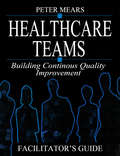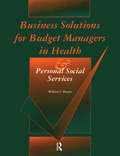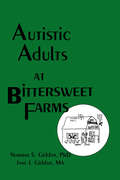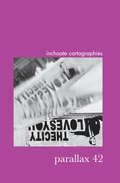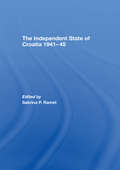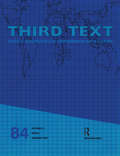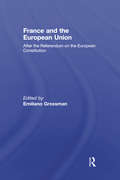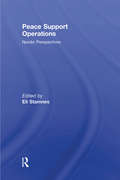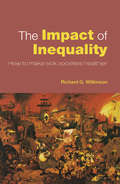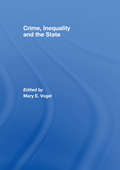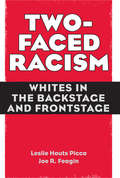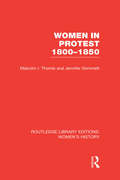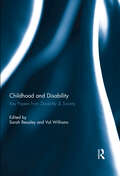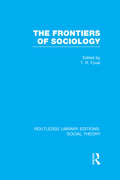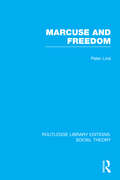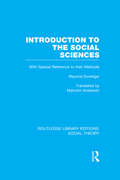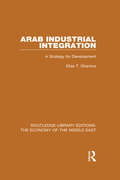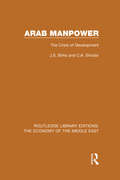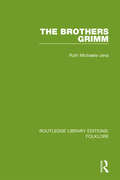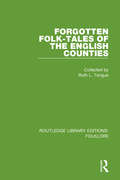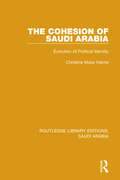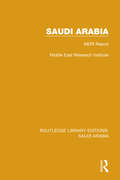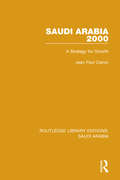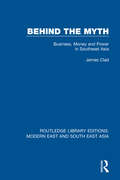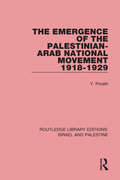- Table View
- List View
Healthcare Teams Manual: Building Continuous Quality Improvement Facilitator's Guide
by Peter MearsThis work provides the reader with an understanding of team building in a health care environment, and shows managers how to build a team that is committed to delivering quality. Topics covered include key quality concepts, team exercises, how to be a team member, team empowerment and continuous quality improvement. The facilitator's guide provides all the lesson plans, overhead projection masters and guides to all the exercises necessary for the team leader or trainer to run a teambuilding workshop.
Business Solutions for Budget Managers in Health and Personal Social Services
by William S. BryansManagers responsible for spending public money in health and social welfare are facing unprecedented pressures to deliver better services against a background of fierce competition for resources, profound organizational change and the creation of internal market places. In this practically-directed book, William Bryans explains how business principles can be applied in the public service context to enable managers to meet this challenge. The author demonstrates how it is possible to create a surplus for service development by effective strategic management of external and internal financial environments, operational management of workloads and resources, and tactical intervention to limit budget fluctuations to tolerable levels. Each chapter includes a purpose statement, an outline of relevant theory and practice, a keypoint summary and a case study based on real world situations.
Autistic Adults at Bittersweet Farms
by Norman Giddan Jane J GiddanAutistic Adults at Bittersweet Farms is a touching view of an inspirational residential care program for autistic adolescents and adults. This compelling book focuses on adult autism treated through the concepts used at Bittersweet Farms, an 80-acre farm in northwest Ohio. Through historical rationale for a therapeutic community, a comparison between the Bittersweet Farms model and treatment settings in the United Kingdom, specific treatments and training programs at Bittersweet Farms, and staff, parent, and resident viewpoints, the innovative program--based on the premise that adults with autism continue to need special care and training throughout their lives--is brought to life. Divided into three sections, Autistic Adults at Bittersweet Farms returns repeatedly to the concept behind the program--molding autistic adults into contributing members of society in their own ways. Section One includes a potpourri of information, giving a glimpse of the range of models available for treatment and what makes each program a success. Taking a closer look at program considerations within various community settings, the second section examines behavior modification techniques in training autistic children and educating their parents. As politics play an important role in developing an innovative care program like Bittersweet Farms, the final section delves into regulations and funding for different types of residential care programs. Ending on a very human and optimistic note, section three closes with three personal accounts of life and work at Bittersweet Farms from a staff member, a resident, and a parent, with each praising a different aspect of the total person care environment of Bittersweet Farms. Occupational and physical therapists, policymakers, educators, and parents of autistic children will be encouraged from reading this outstanding book.
Parallax: 13.1
by Igor Cassar Mark Dawson Eve KalyvaThis book presents themed issues to provoke exploratory, interdisciplinary thinking and response. It provides a forum for a wide spectrum of perspectives on a topical question or concern. The book will be of interest to those working in cultural studies, critical theory, and cultural history.
The Independent State of Croatia 1941-45 (Totalitarianism Movements And Political Religions Ser.)
by Sabrina P. RametThis special issue provides important new scholarship from a variety of perspectives on the structure, ideology and political history of the central fascist group in interwar and Second World War Yugoslavia, the Croatian Ustasha. It is the first volume in English to closely explore the Ustasha’s Independent State of Croatia between 1941 and 1945, a period when it was an active collaborator with Nazi Germany and Fascist Italy, and largely responsible for Yugoslavia suffering the highest proportion of national casualties in the Second World War. By using the top scholars in the field to explore the nature of the NDH, The Independent State of Croatia 1941-45 contributes to scholarly understandings of Croatian nationalism, Balkan politics, European fascism, and genocide in the Second World War.
Third Text: 21.1
by Rasheed Araeen; Ziauddin SardarThird Text is an international scholarly journal dedicated to providing critical perspectives on art and visual culture. Third Text addresses the complex cultural realities that emerge when different worldviews meet, and the challenge this poses to Eurocentrism and ethnocentric aesthetic criteria.
France and the European Union: After the Referendum on the European Constitution (Journal of European Public Policy Series)
by Emiliano GrossmanThe character of international trade has changed dramatically over the past twenty years. Previously published as a special issue of The Journal of European Public Policy, this volume provides a ‘state of the art’ study of the new trade politics.
Peace Support Operations: Nordic Perspectives
by Eli StamnesPeace Support Operations: Nordic Perspectives brings together Nordic academics working in the field of peace support operations broadly defined. It contains a collection of articles that present different theoretical approaches to the study of peace support operations and contribute to enhance the knowledge of the Nordic countries’ participation in such operations. Its case studies describe the development of peacekeeping forces from Norway, Sweden, Denmark and Finland in the face of evolving threats to world security over the past sixty years, and how each country's reaction has differed. The conflicts covered in this study include the Cold War, the Balkan conflict, the first Gulf War and the Malawian ethnic conflict. Thus, it constitutes a contribution to the academic field in both a theoretical and an empirical sense. This book was previously published as a special issue of International Peacekeeping
The Impact of Inequality: How to Make Sick Societies Healthier
by Richard G. WilkinsonIn this book, pioneering social epidemiologist Richard Wilkinson, shows how inequality affects social relations and well-being. In wealthy countries, health is not simply a matter of material circumstances and access to health care; it is also how your relationships and social standing make you feel about life.Using detailed evidence from rich market democracies, the book addresses people’s experience of inequality and presents a radical theory of the psychosocial impact of class stratification. The book demonstrates how poor health, high rates of violence and low levels of social capital all reflect the stresses of inequality and explains the pervasive sense that, despite material success, our societies are sometimes social failures. What emerges is a new conception of what it means to say that we are social beings and of how the social structure penetrates our personal lives and relationships.
Crime, Inequality and the State: A Book Of Readings
by Mary E. VogelWhy has crime dropped while imprisonment grows? This well-edited volume of ground-breaking articles explores criminal justice policy in light of recent research on changing patterns of crime and criminal careers. Highlighting the role of conservative social and political theory in giving rise to criminal justice policies, this innovative book focuses on such policies as ‘three strikes (two in the UK) and you’re out’, mandatory sentencing and widespread incarceration of drug offenders. It highlights the costs - in both money and opportunity - of increased prison expansion and explores factors such as: labour market dynamics the rise of a ‘prison industry’ the boost prisons provide to economies of underdeveloped regions the spreading political disenfranchisement of the disadvantaged it has produced. Throughout this book, hard facts and figures are accompanied by the faces and voices of the individuals and families whose lives hang in the balance. This volume, an essential resource for students, policy makers and researchers of criminology, criminal justice, social policy and criminal law, uses a compelling inter-play of theoretical works and powerful empirical research to present vivid portraits of individual life experiences.
Two-Faced Racism: Whites in the Backstage and Frontstage
by Leslie Picca Joe FeaginTwo-Faced Racism examines and explains the racial attitudes and behaviours exhibited by whites in private settings. While there are many books that deal with public attitudes, behaviours, and incidences concerning race and racism (frontstage), there are few studies on the attitudes whites display among friends, family, and other whites in private settings (backstage). The core of this book draws upon 626 journals of racial events kept by white college students at twenty-eight colleges in the United States. The book seeks to comprehend how whites think in racial terms by analyzing their reported racial events.
Women in Protest 1800-1850 (Routledge Library Editions: Women's History)
by Malcolm I. Thomis Jennifer GrimmettThere is still much uncertainty about the role of nineteenth-century British women in social and political protest. As politics was a man’s world virtually all official accounts and statistics of popular protest deal only with the men involved. It is well known that women participated in food riots and mobilised support for Chartism, and as the dramatic changes in the economy during this period greatly increased the demand for women’s labour, this stimulated their widespread involvement in political and social agitation, particularly the parliamentary reform movement of 1819. First published in 1982, this book provides a descriptive account of the part played by women – mainly working class women – in a variety of social and political activities that can broadly be categorised as protest. It establishes the basic outlines and offers an interpretation of the course of events.
Childhood and Disability: Key papers from Disability & Society
by Sarah BeazleyDrawn from Disability & Society over the period 1997-2012, the twelve chapters in this book address a range of personal, cultural and institutional arenas in which challenges experienced by disabled children are played out. The book includes a mix of theoretical and applied material offering both powerful conceptual tools and practical insights, enabling readers to connect the work of recent decades to their own research and questions about disability and childhood. Readers will find this book an invaluable resource for understanding what we have learned about disability and childhood through the pages of the world leading international journal in the field. The collection makes available a well-informed understanding of conditions, policies and practices that create disability in children's lives so that we can further the struggle for a more inclusive future in which inequalities structured around impairment are removed. The importance of children’s own voices for resisting disablement in childhood is clearly foregrounded in this invaluable collection.This book was originally published as a special issue of Disability & Society.
The Frontiers of Sociology (RLE Social Theory)
by T. R. FyvelThe six essays in this volume are designed to introduce the general reader to some of the main issues in the fields of education, industry, politics, family changes and the like, which concern British sociologists. While each of the essays is independently conceived, their joint aim is to show how sociologists can use empirical methods to throw fresh light on current social problems and also to convey the distinctive approach, the distinctive view of the world towards which sociologists are striving.
Marcuse and Freedom (RLE Social Theory)
by Peter LindThis comprehensive study of Marcuse’s thought concentrates on his theory of freedom, arguing that it is this which supplies the key to all his writings. This argument is substantiated by a detailed chronological examination of Marcuse’s works. The author shows the rigorous logic underlying Marcuse’s thinking, which is often obscured in Marcuse’s own presentation, and pays particular attention to the influence of Heidegger, and of Marx’s notion of human labour. This sympathetic reconstruction of the subject attempts to rescue Marcuse from misunderstanding and superficial criticism, and argues that Marcuse’s most famous work, One Dimensional Man, is in fact an aberration from the mainstream of his work. This book forms one of the most accessible and reliable treatments of Marcuse available.
Introduction to the Social Sciences (Routledge Library Editions: Social Theory)
by Maurice DuvergerProfessor Duverger at last provides the student with an overall view of the methodology of the social sciences. He briefly traces the origin of the notion of a social science, showing how it emerged from social philosophy. Its essential elements and pre-conditions are described; the splintering of social science into specialist disciplines is explained, and the need for a general sociology confirmed. The techniques of observation used by social scientists are dealt with in some detail and the unity of the social sciences is illustrated by examples of the universal application of these techniques. Documentary evidence in its various forms are described along with the basic analytical techniques, including quantitative methods and content analysis. Other methods of gathering information through polls, interviews, attitude scales and participant observation are all described. Professor Duverger brings together the different kinds of analysis used to assess the information thus gathered. Arguing that observing and theorizing are not two different stages or levels of research, he examines the practical value and difficulties of general sociological theories, partial theories and models and working hypotheses. He both describes and assesses the limitations of experiment and the scope of comparative methods in the social sciences. He then gives elementary instructions for using and assessing the value of mathematical techniques. The possibilities of presenting social phenomena through graphs and charts are also explored. There are useful book lists and diagrams.
Arab Industrial Integration: A Strategy for Development (Routledge Library Editions: The Economy Of The Middle East Ser.)
by Elias T. GhantusThe Arab countries are increasingly recognising their importance as a regional economic grouping. Given the highly skewed distribution of natural, human and financial resources, the course of economic development in the Arab countries seems to be interrelated. Through pooling their resources and markets these countries will not only be able to optimise investment decisions but also broaden the potential for development. This book argues that economic integration is not merely a question of reducing or eliminating discriminatory measures, as emphasised in previous integration attempts. It calls rather for a positive action based on a regional investment strategy which coordinates production programmes, to reap the benefits of specialisation and scale. The book focuses on past industrialisation efforts in the Arab countries and examines the emerging patterns of industrial growth. A pioneering attempt is made to identify specific industries whose economic viability can be enhanced by conceiving them on a regional basis. The book concludes by framing a strategy for an integrated industrial development in the Arab region.First published in 1982.
Arab Manpower (RLE Economy of Middle East): The Crisis of Development
by J.S. Birks C.A. SinclairThe Arab world increasingly falls into two divisions, the capital-poor and the capital-rich countries (where capital means, in essence, oil). In the capital-rich countries shortage of labour is the chief constraint on growth. In the capital-poor countries analysis of the labour market is equally central, as shortage of labour compounds the already existing problem of shortage of capital. This book surveys the labour markets of the Arab world state by state, evaluating them by demand and supply analysis, and analysing the different elements in trends of employment. It forecasts the areas of stress in the next decade and suggests ways of minimising them. The book, based on much previously unpublished information and on extensive on-the-spot research in the respective Arab countries, sets out the economic and social conditions which underly the impending crisis of development in the Arab region.First published in 1980.
The Brothers Grimm (RLE Folklore)
by Ruth Michaelis-JenaThis is the first modern biography of the Brothers Grimm, first published in 1970. It is a study of them in their background of late eighteenth-century and nineteenth-century Germany, and shows the position they held in their society as founders of Germanic philology, as members of the 'Göttingen Seven', and inside the circle of the German Romantics. Jacob and Wilhelm Grimm were pioneers in the recording of authentic traditional stories. Gradual revisions gave these tales the form in which they have come down to us. Even if more recently the custom has been to leave stories as they were told, the astonishing currency of the Grimms' collection is due largely to the brothers' editorial work. The Grimms' lasting fame, as Michaelis-Jena points out, may well rest on the fact that by their insistence on 'genuine and true recording' they turned the amateur antiquarian into the professional folklorist. Ruth Michaelis-Jena has worked for many years on the Brothers Grimm, and has had access to little known material at various libraries and museums in Germany.
Forgotten Folk-tales of the English Counties (RLE Folklore)
by Ruth TongueIn this book, first published in 1970, Ruth L. Tongue has collected a number of county folk tales recorded by her from childhood onwards, from old people, village children and farm round-the-fire sessions. Many of the beliefs embodied in the gipsy and witchcraft tales are still in practice today among the travelling people and locally ‘gifted’ healers. The tales reveal a good deal of fairy lore, some tree lore, including ghostly trees like Crooker, and the ‘uncanny’ Black Dog makes his appearance in more than one tale. The collection includes several of the long fireside tales which would be told on succeeding evenings on winter nights round the kitchen fire, and rhozzums from various localities.
The Cohesion of Saudi Arabia (RLE Saudi Arabia): Evolution of Political Identity
by Christine HelmsSaudi Arabia is no longer regarded as quite the invincible pillar of Islam it so recently seemed. Its authority within the Islamic world has been challenged by the Ayatollahs in Iran and its dominant position within Opec has been seriously eroded. Most importantly, the dramatic assault on the Mosque at Mecca has raised serious doubts about the internal security of the Saudi regime. This study provides essential background to the contemporary problems of Saudi Arabia in its focus on the early years of the Saudi state and the way in which King Abd al-Aziz first created a nation state and asserted his family's authority. It agues that the geography of Central Arabia was a crucial factor in determining how he fused together the Bedouin tribes and the settled communities into a political entity. First published in 1981 and based on extensive new research data, this is the first study to examine more than simply a political or diplomatic history of Saudi Arabia, and concerns itself with the attitudes and perceptions of the Arabs themselves towards political initiatives of that period.
Saudi Arabia (RLE Saudi Arabia): MERI Report
by Middle East Research InstituteThe MERI Reports on the Middle East quickly established themselves as the most authoritative and up-to-date information on the state of affairs in the region. This study, focusing on Saudi Arabia was fist published in 1985, provides vital analysis of the political and economic issues affecting the country. It combines a crisp and incisive survey of the politics and economy of the country, as well as providing statistical material on all the key data of the political economy. 1. Background 2. Political Analysis 3. Economic Analysis 4. Saudi Arabian Statistical Appendix
Saudi Arabia 2000 (RLE Saudi Arabia): A Strategy for Growth
by Jean CleronThe sharp increase in both the price of crude oil and resulting revenues to Saudi Arabia has seen the rapid growth of the kingdom’s international trade and a large accumulation of financial assets. These sudden and drastic changes have taken place, however, within a mainly traditional economy, unprepared to cope with a massive increase in government revenues. Long-term planning is therefore of the utmost importance to Saudi Arabia, and this study, first published in 1978, presents a detailed analysis of the structure of the kingdom’s economy, represented by a dynamic simulation model. The first part of the book considers, among other issues, the production of crude oil, the non-oil production, the accumulation of productive capital, the Saudi population and labour force, the mechanism of domestic inflation, and the relationship of Saudi Arabia with the rest of the world. The second part then presents simulation experiments conducted upon the model, which are commented on and analysed. A concluding chapter illustrates how such a study may be extended to cover several other countries in the Middle East.
Behind the Myth (RLE Modern East and South East Asia): Business, Money and Power in Southeast Asia
by James CladFor most people, the ‘economic miracle’ in Asia means Japanese, Korean or Taiwanese dynamism. Less is known about Southeast Asia, where economies grouping over 300 million people have clocked astounding growth rates since 1970. But fast growth is only part of the story. In this book, first published in 1989, James Clad offers an inside look at Malaysia’s ‘kampong commerce’, at oil-rich Brunei’s ‘Shell-fare state’ and at Thailand’s business blend of bureaucrats, generals and local Chinese. The author opens the window on business politics in Indonesia and the Philippines, as well as explaining how Singapore, although a notable exception to economic passivity and business corruption, still remains hostage to geography and overseas Chinese insecurity. Apart from these country surveys, this book also analyses the constants of South East Asia and Hong Kong, including commodity earnings and the financial power of the Chinese. It describes claims of ‘intellectual dishonesty’ at Asia’s largest development bank and counters fashionable optimism that weak regional institutions will evolve into an Asian common market. Yet Clad also describes South East Asia’s impressive achievements, including an account of how their new multinational companies are feeling their way into the world economy.
The Emergence of the Palestinian-Arab National Movement, 1918-1929 (RLE Israel and Palestine)
by Yehoshua PorathThe resurgence of Palestinian nationalism in the wake of the 1967 Arab-Israeli war tended to overshadow the fact that Palestinian national consciousness is not a new phenomenon, but traces its origins back to the time when the first stirrings of nationalism were being felt in many parts of the under-developed world. This work, first published in 1974, is based on both Arabic and Hebrew primary sources as well as English and French official and unofficial documents, and was the first detailed study of the infancy period of Palestinian nationalism. The book begins by establishing the position of Palestine and Jerusalem in Islamic history and their significance within the concepts of Islam, and outlines the social and political features of the Palestinian population at the beginning of the First World War. The author then charts in detail the development of Palestinian nationalism over the decade after the War. Two major forces influenced this development and reacted with it: Zionism, with its ambitious schemes for settling Jews in Palestine and creating a National Home for them there, and Arab nationalism on a wider scale, which was emerging spontaneously with the disintegration of the Ottoman Empire and the spreading of ideas of self-determination. The growing threat posed by Zionism awoke the Palestinian population to the need for organization and the establishment of their own identity to oppose it, while the focus of their national aspirations widened or narrowed according to the ability which they felt at any given time to confront Zionism and achieve self-expression within a Palestinian rather than an all-Syrian national framework. The events of these turbulent years – the confrontations with the British, delegations, boycotts, proposals and rejections, the emergence of al-Hajj Amin al-Husayni, the Wailing Wall conflict and its repercussions – are all described within the context of these wider considerations, which also include Britain’s own role as holder of the Mandate over Palestine.
